Imagine stepping into a living room that instantly calms and rejuvenates your spirit—welcome to the world of Sage Green Living Room Ideas! This soothing hue has skyrocketed in popularity because of its ability to evoke tranquility, sophistication, and a touch of nature, making it perfect for creating a peaceful sanctuary at home.
In this article, you’ll uncover a variety of inspiring ideas to incorporate sage green into your living space, from subtle accents to bold statements. Whether your style is modern, rustic, or eclectic, these ideas will help you craft a serene environment that reflects your personality and brings a fresh, natural vibe to your home.
1. Soft Sage Wall Paint for Calm and Cohesion
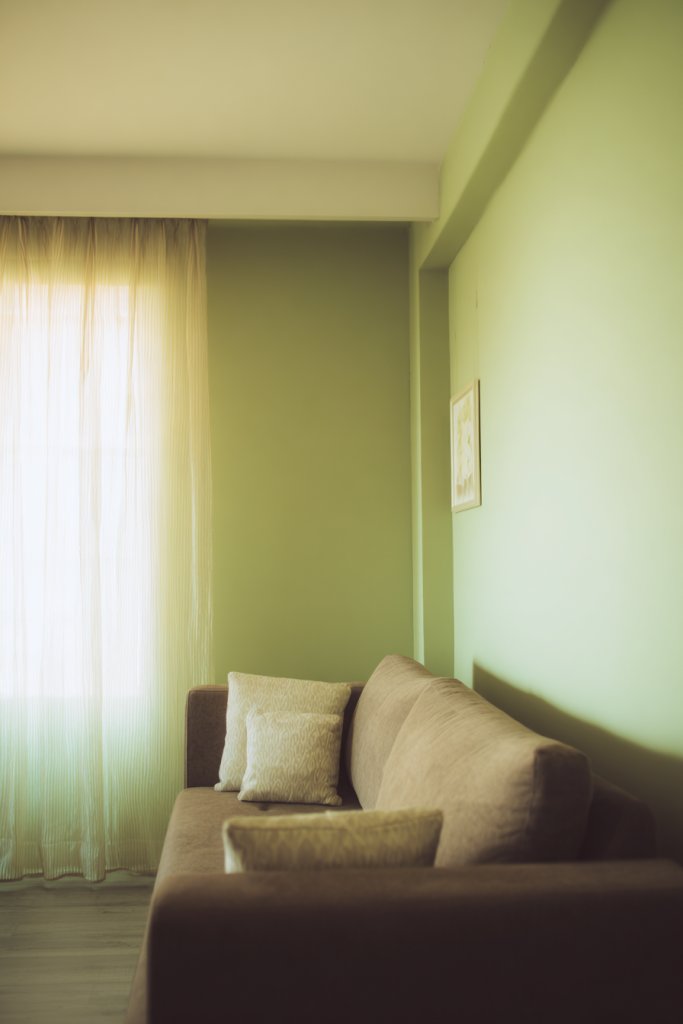
Ever wish your living room could instantly soothe your mind after a long day? Sometimes, the hardest part is creating a space that feels both peaceful and inviting without resorting to overwhelming colors. Sage green offers that perfect balance—calming without dull, lively yet serene. If your walls are stuck in a rut or feel stark, a fresh coat of soft sage might just be the reset you need.
Imagine walking into a room bathed in a gentle, muted green that seems to wrap you in calm. The walls have a matte finish, absorbing harsh light and reflecting a warm, inviting glow. The color pairs beautifully with natural textures like woven baskets or soft linen sofas. Subtle shadows cast by ambient light create a cozy, layered look, making the space feel both spacious and intimate at the same time.
This hue adapts effortlessly to different styles—think modern minimalism with crisp white accents or rustic charm with wooden beams. During winter, pair it with warm textiles like plush throws, while in summer, it complements light, airy curtains. You can also tweak the shade slightly—more gray for a cool vibe or a touch of yellow for warmth. It’s versatile enough to evolve with your changing tastes.
Start by choosing a high-quality, low-VOC paint in a soft sage tone. Prep your walls by cleaning and patching any imperfections. Use painter’s tape to achieve clean edges, especially around trim and ceilings. Apply primer if your previous color is dark or contrasting, then use a roller for an even coat. For best results, two coats are recommended, allowing drying time between layers. Finish with a semi-matte or matte topcoat for a subtle, sophisticated look.
Add depth with textured wall finishes like subtle plaster or faux stucco in the same hue. For a personalized touch, incorporate painted wood paneling or shiplap in matching shades. You could also layer in complementary colors through accessories like cushions or artwork—think warm taupes, creams, or muted golds. Small changes, like changing the sheen, can dramatically alter the room’s mood.
A soft sage wall provides a neutral yet distinctive backdrop that promotes tranquility. It’s a timeless choice that works well with current design trends focused on wellness and mindfulness. Your space will radiate calm and sophistication, making it easier to unwind and reconnect. Ready to transform your living room into a peaceful oasis? Go ahead—your walls are waiting for a soothing touch.
2. Layered Textures with Neutral Rugs and Throws
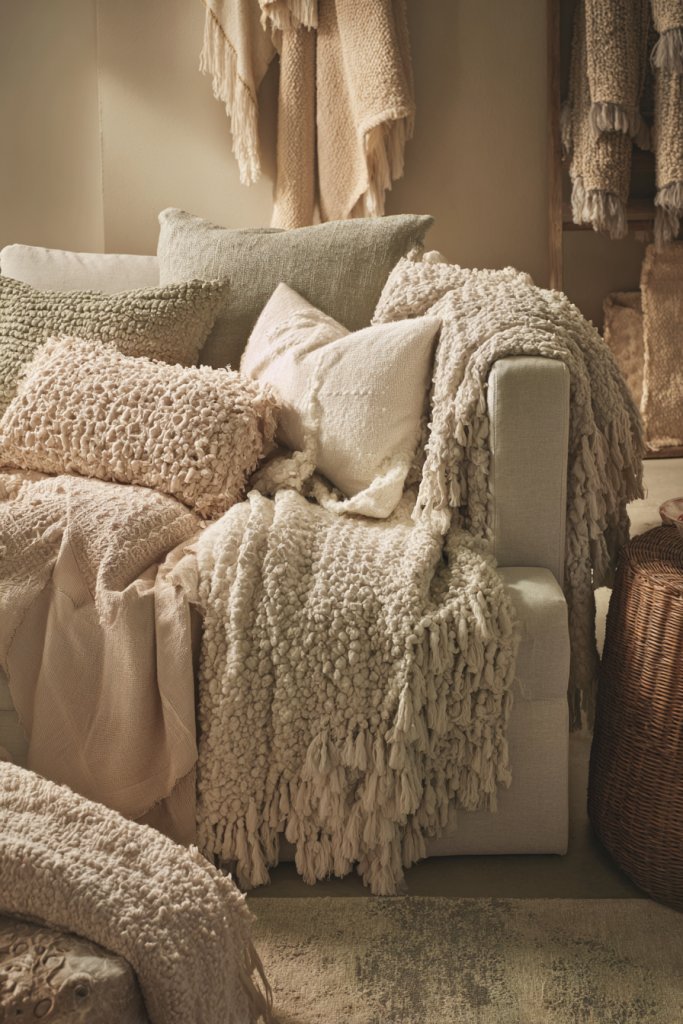
Does your living space feel flat or uninviting despite having good furniture? Sometimes, all it takes is adding the right textures to bring warmth and depth. Layering different textiles creates a cozy, multidimensional ambiance that makes the room feel alive. If your decor looks too uniform or sterile, textured rugs and throws can be game changers.
Picture a plush, neutral-toned rug with a chunky knit pattern spread across the floor, inviting bare feet to sink in. Drape a soft, cream-colored throw blanket over a sofa with a tactile weave, adding a sense of comfort. Mix in textured cushions with fringes, tassels, or embroidery for visual interest. The combination of different fabrics and finishes creates a layered, inviting environment that appeals both to the eye and touch.
For a minimalist look, choose rugs with subtle textures like loop pile or flatweave in neutral shades. If your style leans boho, incorporate layered rugs with different patterns and textures for a more eclectic vibe. During winter, opt for thicker, warmer throws and rugs, while lighter fabrics work well in summer months. You can also experiment with tactile wall coverings or textured curtains for added depth.
Start with a neutral, durable rug as your foundation. Look for high-pile options for softness or flatweaves for an understated look. Add throws made from cozy materials like wool, chenille, or faux fur—fold or drape them strategically. Mix different textures and patterns, but keep the color palette cohesive to avoid visual chaos. Layer cushions with varied weaves and embellishments to enhance tactile richness.
Personalize by selecting textiles in your favorite shades or with meaningful patterns—perhaps a vintage kilim or a handwoven blanket. Incorporate tactile elements like faux animal fur or velvet cushions for a luxe feel. Use decorative storage baskets made from woven materials for extra texture and functionality. Creating a tactile sanctuary is all about mixing and matching to suit your comfort style.
Textured layers turn a simple space into a sensory delight, making your living room both stylish and cozy. It’s a simple way to add personality without major renovations. Plus, these textiles are easy to swap out seasonally or as your mood changes. Embrace the tactile richness—your space will feel more like a warm hug than just four walls.
3. Minimalist White Furniture for a Fresh Look
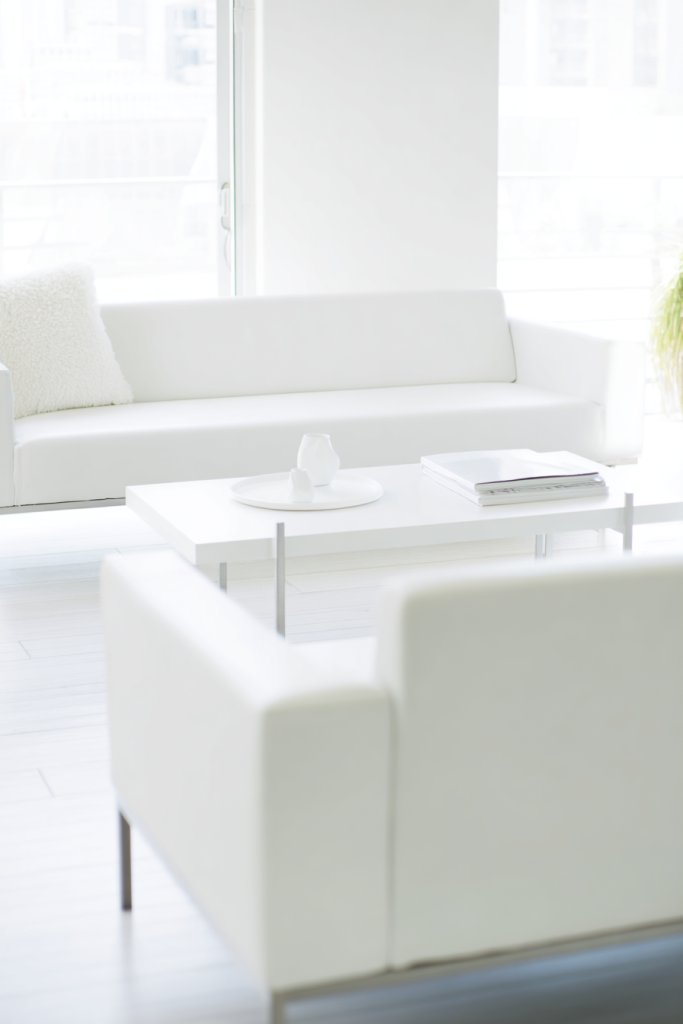
Feeling overwhelmed by a cluttered or overly busy living room? Sometimes, less really is more. White furniture offers a clean, crisp aesthetic that instantly refreshes any space. It creates a sense of openness and light, making even small rooms feel larger and more inviting. If your current setup feels heavy or outdated, switching to minimalist white pieces could be your solution.
Imagine sleek white sofas with thin, metal legs paired with a simple white coffee table. The furniture’s smooth surfaces reflect natural light, enhancing the airy feel. Add soft neutral accessories like textured throws or subtle rugs to soften the look. Keep decorative items minimal—perhaps a single sculptural piece or a set of monochromatic candles—to maintain the fresh, uncluttered vibe. The overall aesthetic feels modern, calming, and effortlessly sophisticated.
Choose furniture with clean lines and simple shapes for a contemporary vibe. You can also mix in natural elements like light wood accents or subtle metallic hardware for contrast. For a cozy touch, layer in plush textiles and soft cushions. This style adapts well to various decor themes—from Scandinavian to industrial—by tweaking accessories and finishes. During different seasons, swap out textiles or add colorful throws for variation.
Start with a foundation of white furniture that’s durable and easy to clean. Opt for pieces with sleek, streamlined profiles—think low-profile sofas and streamlined consoles. Keep surfaces clutter-free by incorporating discreet storage solutions. To prevent the white from feeling clinical, introduce warm-toned textiles or natural fibers. Use subtle metallic or textured accents to add visual interest without disrupting the minimalist vibe. Regularly declutter to keep the look pristine.
Personalize with unique textured throws, patterned cushions, or decorative trays in muted tones. Consider adding a statement piece like a sculptural side table or an abstract sculpture—something simple but eye-catching. Incorporate soft lighting through sconces or hidden LED strips to create different moods. Use artwork or accessories sparingly to maintain the clean aesthetic while reflecting your personality.
White furniture amplifies natural light and makes your living room feel fresh and spacious. It’s a versatile base that works with virtually any color scheme or style. With a little strategic layering and personal touches, you can easily evolve your space over time. Who knew minimalism could be so impactful? Dive into the simplicity—you’re about to love your new, breezy space.
4. Natural Wood Accents for Warmth and Earthiness
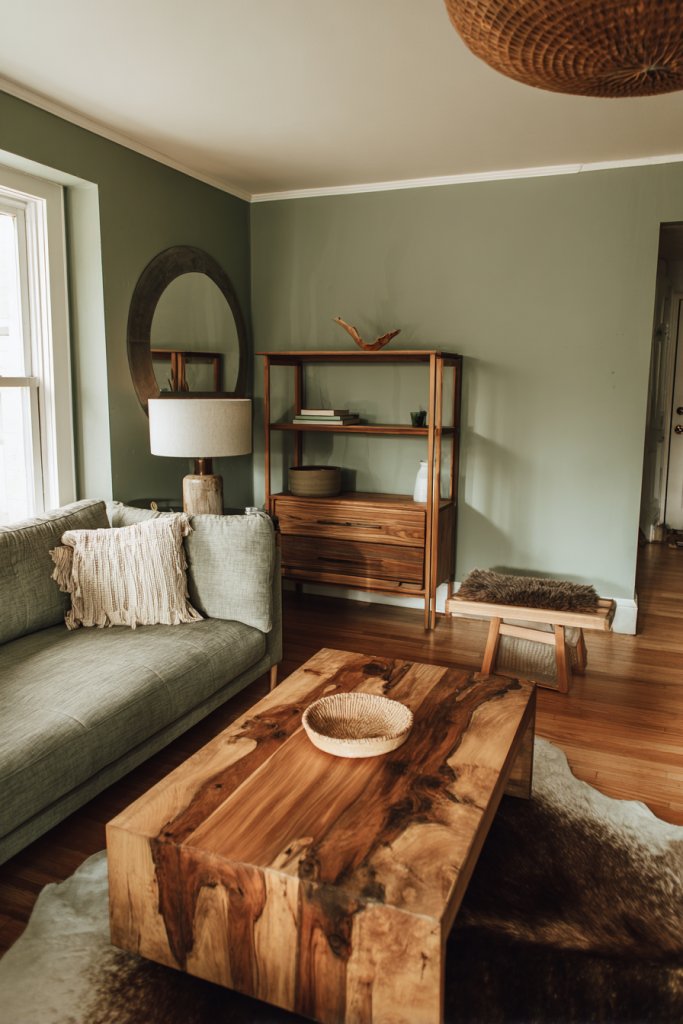
Ever feel like your living room lacks that cozy, grounded vibe? Wooden accents are the perfect way to introduce warmth and texture without overwhelming your space. They evoke a sense of nature and calm, making your home feel more inviting. If your decor feels sterile or too polished, adding natural wood elements can instantly change the mood.
Picture a coffee table crafted from reclaimed oak with a matte finish, its rough texture contrasting beautifully with smooth fabric upholstery. Wooden picture frames, shelves, or side tables bring an organic touch that softens the overall look. The warm tones of the wood complement neutral or sage walls, creating a harmonious environment. The grain patterns and natural imperfections add character and depth, elevating the aesthetic.
Use light woods like birch or maple for a Scandinavian or modern aesthetic, or opt for darker woods like walnut for a richer, more traditional look. During winter, layer in plush textiles and warm-colored accessories to enhance the cozy feel. In summer, pair wood with breezy fabrics and bright accents for a fresh vibe. Mixing different wood tones can create a layered, eclectic look or a more cohesive monochrome scheme.
Start by selecting quality wood furniture or decorative accents that match your style. Look for pieces with visible grain or unique knots for extra personality. Incorporate wooden trays, bowls, or candle holders to add tactile interest across your space. To prevent the room from feeling heavy, balance wood elements with soft textiles and light-colored walls. Regular maintenance includes dusting and occasional oiling or sealing to preserve the finish.
Create a gallery wall with a mix of wooden frames and art prints—avoiding wall decor restrictions—focusing on textures and natural materials. Incorporate handcrafted wooden sculptures or carved accents for a bespoke touch. Use wooden storage boxes or baskets to organize essentials while adding visual warmth. Personal touches like engraved plaques or painted wood pieces can make the space uniquely yours.
Natural wood accents ground your living room with an earthy vibe that’s both timeless and stylish. They connect your decor to nature, promoting a calming atmosphere. Combining different textures and finishes keeps the look fresh and engaging. Dive into the warmth of wood—you’ll love how it transforms your space into a cozy retreat.
5. Botanical-Inspired Art for a Subtle Nature Touch
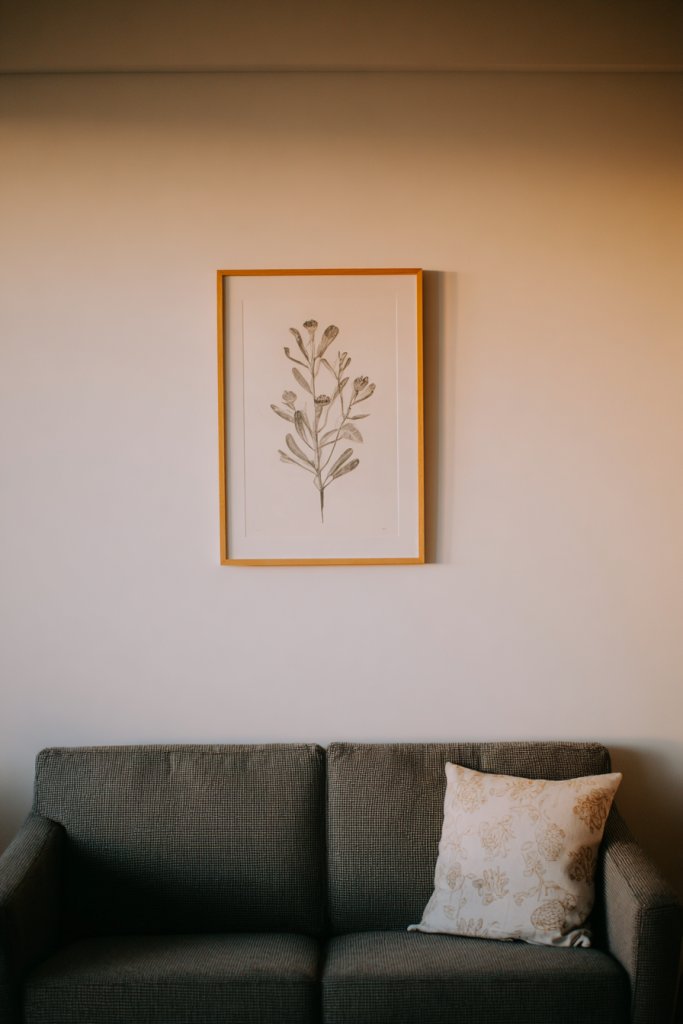
Craving a touch of nature without turning your living room into a jungle? Botanical-inspired art offers a sophisticated way to bring the outdoors in. It adds visual interest and a calming influence, perfect for creating a peaceful retreat. If your walls are feeling empty or sterile, a subtle botanical touch can change the entire vibe.
Imagine a series of minimalist prints featuring abstract leaves or soft botanical sketches in muted greens and neutrals. These pieces hang in sleek frames above a neutral sofa, adding depth and tranquility. The artwork’s delicate lines and subdued colors complement the sage palette, enhancing the room’s organic feel. The overall effect is calming, with a refined, modern twist.
Opt for black-and-white line drawings for a minimalist aesthetic or watercolor botanical prints for a softer, more romantic vibe. Layer multiple pieces for a gallery wall, or keep it simple with a single large print. During different seasons, switch out artwork to reflect nature’s changes—think lush greens in spring or muted tones in winter. Frame the art in sleek, simple frames to keep the look cohesive.
Choose artwork that echoes your preferred style—minimalist, vintage, or contemporary. Hang at eye level for maximum impact, using discreet mounting hardware to keep it clean. Avoid overly busy or colorful botanical art that might clash with your overall palette. Incorporate art that’s easy to update or rotate, ensuring your space stays fresh without much effort. Regularly dust frames and keep glass clean for optimal presentation.
Create a personalized gallery by mixing botanical prints with personal photographs in botanical-inspired frames. Add textured mats or layered mats for depth. Incorporate small decorative objects like ceramic planters or textured ceramics—avoiding restricted decor—to complement the art. Use complementary wall colors or textured wall coverings to enhance the botanical theme.
Botanical-inspired art subtly connects your space to nature, promoting relaxation and mindfulness. It’s a versatile decor choice that enhances the tranquil vibe of your living room. With simple framing and strategic placement, you can create a gallery that feels both curated and calming. Ready to add a touch of nature’s beauty? Art is your new best friend.
6. Layered Lighting with Warm LED Fixtures

Ever walk into a room that feels flat or uninviting? Proper lighting can totally transform a space, making it cozy and welcoming. Layered lighting—combining different sources—adds depth and ambiance that a single overhead fixture can’t match. If your living room feels dull or too bright in spots, a thoughtful lighting plan can fix that.
Picture a soft glow from a floor lamp with a textured fabric shade, complemented by warm LED strip lights tucked behind shelves or along architectural features. A set of small table lamps on side tables adds pools of warm light perfect for reading or relaxing. Overhead, a dimmable fixture provides adjustable general illumination. The combination creates a layered, inviting environment that adapts to your mood.
Choose fixtures with warm-toned bulbs for a cozy glow and varying styles—from sleek modern sconces to vintage-inspired lamps. Use dimmers to control light intensity, making the space adaptable for different activities or times of day. During holidays or special occasions, swap in decorative bulbs or fixtures to add a festive touch. Align lighting design with your overall decor theme for a cohesive look.
Assess your room’s layout—identify dark corners, focal points, and areas needing task lighting. Combine ambient, task, and accent lighting for a balanced effect. Install dimmers where possible to easily adjust mood. Use warm LED bulbs for energy efficiency and a cozy feel. Position fixtures at different heights for visual interest and to avoid harsh shadows. Regularly clean fixtures and replace bulbs as needed.
Incorporate statement lighting pieces—like sculptural floor lamps or decorative sconces—that reflect your style. Add dimmable smart bulbs for customized scenes and color options. Use textiles like textured shades or fabric-covered fixtures for softness. Personalize the space further by adding candles or faux candles that enhance the layered lighting effect without the restricted decor items.
Good lighting transforms your living room into a versatile, mood-enhancing space. It’s an easy upgrade with a big impact—no major renovations needed. Layered lighting gives you control over ambiance, making your space feel cozy, functional, and stylish. Brighten your home and your mood—your living room deserves it.
7. Open Shelving with Simple Decor for Visual Breathing Space

Do cluttered shelves make your living room feel chaotic? Open shelving is a smart way to display essentials while maintaining a spacious, airy feel. It allows you to curate your decor, showcasing your personality without overwhelming the space. If your room is looking cramped or cluttered, a few well-chosen open shelves might be just what you need.
Imagine sleek, floating shelves mounted against a neutral wall, with a few curated objects—like textured ceramics, woven baskets, or minimalist books—carefully arranged. The open design creates a sense of depth, making the room appear larger. Keep the clutter to a minimum, with each item thoughtfully placed to add interest without overcrowding. This creates a clean, organized look that still feels personal and inviting.
Use open shelving to display a mix of functional and decorative items—such as storage boxes, small sculptures, or framed quotes—avoiding the restricted decor items. During different seasons, swap out accessories for fresh looks—think cozy textiles in winter or airy ceramics in summer. For small spaces, opt for narrow or corner shelves to maximize utility without crowding. Implement a uniform color palette to keep the look cohesive.
Select sturdy, wall-mounted shelves that match your room’s style—whether sleek metal or natural wood. Securely anchor shelves into studs for safety, especially if displaying heavier objects. Keep styling simple: group similar items and leave some space between objects for visual clarity. Regularly dust and tidy the shelves to maintain a fresh, uncluttered appearance. Use decorative baskets or boxes underneath for hidden storage.
Personalize shelves with meaningful objects—like handcrafted ceramics or vintage finds—while avoiding restricted decor. Incorporate textured elements, such as woven baskets or fabric-lined boxes, to add warmth. Use lighting—like small LED strip lights—to highlight your displays, creating a layered visual effect. Keep the overall look cohesive by sticking to a limited color palette or theme.
Open shelving showcases your style in a curated, organized way that feels fresh and intentional. It makes your living room more open and accessible, perfect for displaying favorite items. With thoughtful styling, your shelves become a focal point that enhances the entire space. Embrace the simplicity—your room will feel more spacious and personalized.
8. Incorporating Textured Wall Panels or Cladding
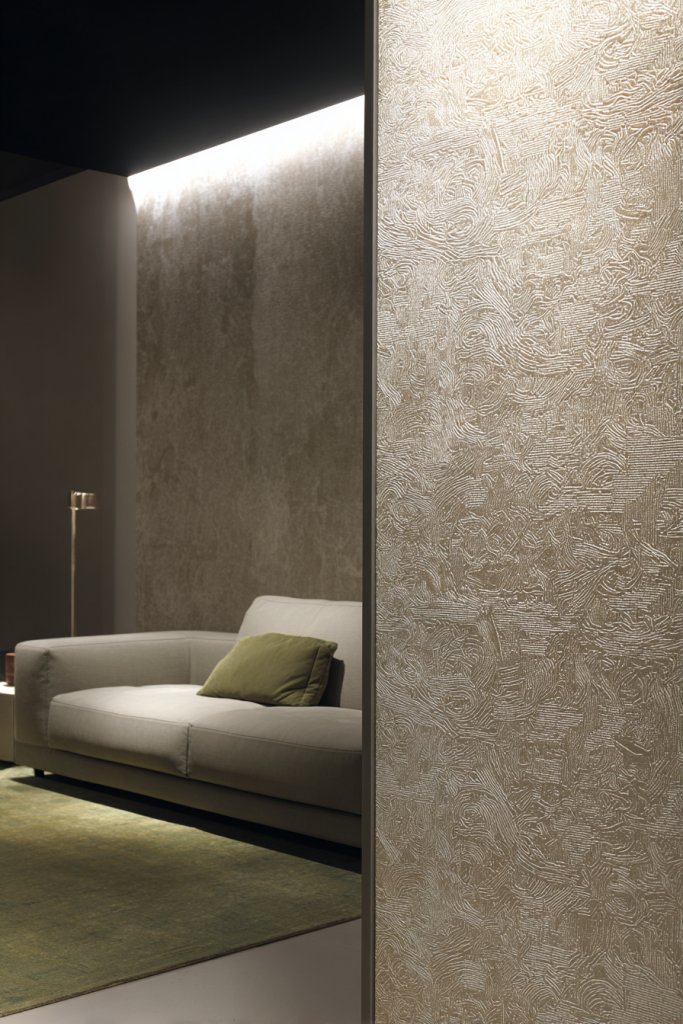
Feeling like your walls are too flat or boring? Textured wall panels or cladding add instant dimension and interest. They create a focal point that elevates your decor without needing artwork or wall decor. If your space feels dull or lacks personality, textured wall treatments can be a game-changer.
Imagine a feature wall covered in subtle wood grain panels or geometric textured tiles in neutral tones. The tactile surface catches light differently throughout the day, creating shadows and depth. It complements soft furnishings and layered textiles, emphasizing the room’s organic and calming vibe. The textured wall becomes a conversation piece that adds sophistication and warmth.
Choose panels with natural materials like wood or bamboo for an earthy look, or go for modern geometric patterns in neutral colors. During different seasons, you can add removable covers or paint over certain areas for variety. Use textured wall panels behind your sofa or in entryways to create visual anchors. Keep the surrounding decor minimal to let the panels shine.
Select textured panels that suit your aesthetic—wood slats, 3D tiles, or woven wood panels. Prepare the wall surface—clean, patch, and prime if needed. Use adhesive or mounting hardware recommended by the manufacturer for secure installation. Ensure precise measurements for pattern alignment. Finish with sealing or protective coatings if required, and clean the surface regularly to maintain texture clarity.
Customize panels with paints or stains to match your color scheme, or add decals or stencils for a unique look. Layer in soft textiles, like curtains or cushions, to contrast with the tactile wall. Incorporate lighting—such as hidden LEDs—to highlight the texture and create a dynamic atmosphere. Personal touches turn a simple wall into a statement piece.
Textured wall panels add depth and personality, making your living room stand out effortlessly. They blend natural and modern elements, creating a balanced, tranquil environment. With minimal effort, you achieve a high-impact transformation. Ready to give your walls a tactile makeover? It’s easier than you think—and totally worth it.
9. Use of Soft, Natural-Linen Curtains for Privacy and Light
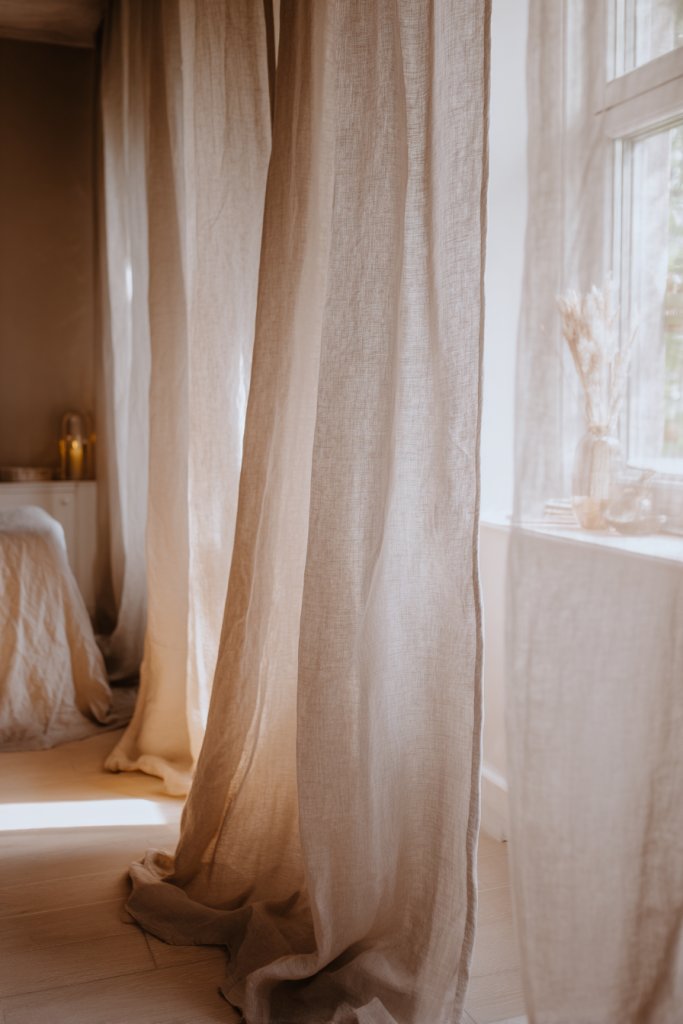
Ever struggle with balancing privacy and natural light in your living room? Heavy drapes can block light but offer little privacy, while sheer curtains might leave you exposed. Soft linen curtains provide a perfect middle ground—diffusing light gently while maintaining privacy. If your windows feel stark or unfinished, linen curtains can soften and elevate the space.
Imagine flowing, slightly textured linen curtains in a light neutral tone framing your windows. During the day, they filter sunlight into a warm, diffuse glow, lighting up the room naturally. When drawn, they create a soft, elegant barrier that maintains privacy without feeling oppressive. The fabric’s natural wrinkles and subtle weave add to the room’s organic, calming atmosphere.
Choose linen in shades ranging from creamy whites to muted taupes, matching your overall palette. During summer, go for lightweight, airy fabrics; in winter, layer with heavier drapes or add thermal linings. For a boho look, opt for textured or fringed linen, while minimalist styles benefit from sleek, unadorned panels. Shorter curtains or blinds can be used for a more modern, functional approach.
Measure your windows carefully to determine the right length and fullness. Hang curtain rods slightly above the window frame for a taller, more spacious feel. Use fabric rings or discreet hooks for easy opening and closing. Choose high-quality linen that’s pre-washed for softness and durability. Regularly wash and iron if needed, or embrace the natural wrinkles for a relaxed look.
Add personal touches with tiebacks or decorative rods that match your decor style. Layer linen curtains with sheer or blackout blinds for versatility. Incorporate decorative finials or end caps in metals or wood for a custom finish. Play with different textures and colors in accessories to reflect your personality and seasonality.
Soft linen curtains enhance your living room’s tranquility while offering privacy and light control. They add a natural, effortless charm that complements your overall decor style. Easy to update, they help your space adapt to changing seasons or moods. Embrace the gentle flow—your room will feel more inviting and peaceful.
10. Creating a Cozy Reading Nook with Plush Armchair

Ever wish you had a quiet corner dedicated to reading and relaxing? A cozy nook transforms a corner of your living room into a personal retreat. It invites you to unwind, disconnect, and indulge in your favorite books. If your space feels too open or lacks intimacy, carving out a dedicated spot can make all the difference.
Picture a plush, oversized armchair with soft textured upholstery, nestled in a corner with a small side table nearby. Layer it with a chunky knit throw and a few textured cushions to boost comfort. Soft lighting—like a wall-mounted sconce or a small floor lamp—creates a warm glow. Adding a small rug underneath grounds the space, making it feel like a true retreat within your home.
Choose an armchair in a neutral or muted tone that complements your overall palette. During colder months, add a cozy blanket or textured cushions in seasonal colors. For a minimalist look, keep accessories simple—perhaps a small stack of books or a ceramic cup. If space is tight, opt for a compact chair or a window seat with built-in storage.
Select a comfortable, supportive armchair in a durable fabric or leather. Position it near a window or in a quiet corner for the best ambiance. Add a small side table for books, drinks, or your favorite snack—just don’t clutter the space. Incorporate a soft, warm light source that creates a relaxing atmosphere. Finish with a textured rug or a small basket for additional comfort.
Personalize your nook with a small collection of your favorite books or decorative objects—avoiding restricted decor. Add a textured throw blanket or a unique pillow in your signature colors. Incorporate a small plant or decorative sculpture nearby—avoiding restricted items—and consider a small wall-mounted shelf for extra storage. Keep the space tidy and inviting.
A dedicated reading nook makes relaxing at home effortless. It creates a personal sanctuary that encourages daily unwinding. With just a few well-chosen pieces, your space becomes a haven for comfort and inspiration. Ready to cocoon yourself in style? Your perfect nook awaits.
11. Incorporating Subtle Metallic Accents for a Touch of Glam
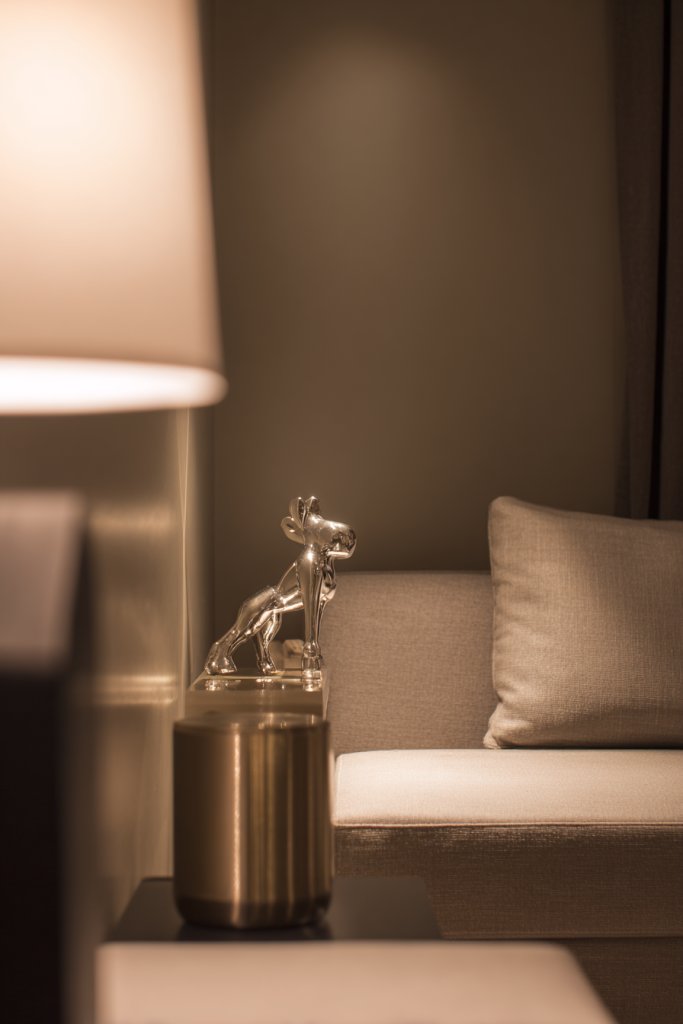
Want to add a dash of elegance without overpowering your tranquil space? Subtle metallic accents provide just the right amount of glamor—think gold, brass, or brushed nickel—adding shine and sophistication. They elevate your decor with minimal effort and keep the look refined. If your room feels flat or lacks a luxe vibe, these accents can be your secret weapon.
Imagine a set of brass candle holders on a minimalist side table or a brushed gold picture frame on a neutral wall. Small metallic details catch the light, creating a warm glow that enhances the room’s ambiance. Incorporate metallic accessories in textures—such as matte, brushed, or polished—to add depth. The contrast of shiny metal against soft textiles or matte surfaces creates a layered, upscale aesthetic.
Choose warm metals like brass or gold for a cozy, inviting feel, or cooler tones like nickel or chrome for a sleek, modern look. Use metallic finishes on fixtures, hardware, or decorative objects—avoiding overly ornate or busy designs. During seasonal updates, swap out accessories or add metallic accents to existing furniture or decor items. Pair with neutral or muted palettes to keep the look elegant and understated.
Select small metallic decor pieces—like vases, trays, or sculptures—that complement your overall style. Use these accents sparingly to avoid visual clutter. Place metallic objects at different heights for a dynamic effect. Clean metal surfaces regularly with appropriate cleaners to maintain their shine. Incorporate metallic hardware on furniture or fixtures for a more integrated look, ensuring consistency in finishes.
Personalize with custom metallic objects—like engraved trays or handcrafted sculptures—that reflect your taste. Mix different metallic finishes for a layered look, but keep it cohesive. Use metallic paint or adhesive accents to update existing furniture or decor. Incorporate textured or matte finishes to add visual interest and prevent the look from feeling too shiny or cold.
Metallic accents effortlessly add a touch of luxury, making your living room feel more polished. They complement natural textures and soft fabrics, creating a balanced, elegant environment. With subtle details, you can create a space that feels both sophisticated and inviting. Small touches make a big difference—embrace the shimmer.
12. Using Artistic Ceramic or Stone Decor in Neutral Tones
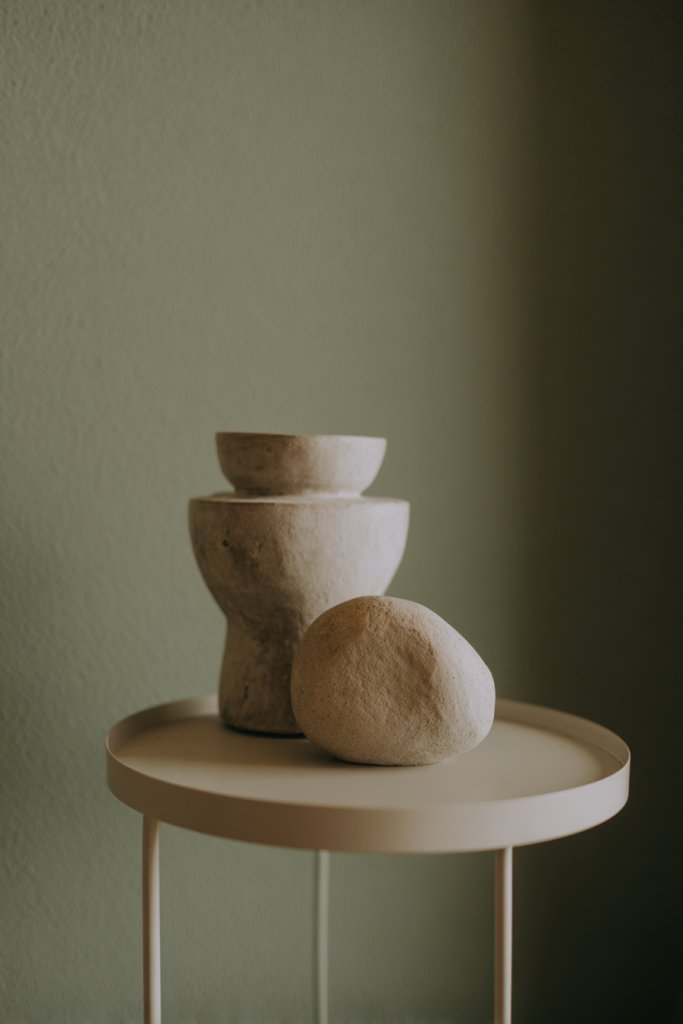
Looking for decor that feels handcrafted and timeless? Artistic ceramics and stone pieces in neutral tones add artisanal charm and texture to your space. They provide visual interest without overpowering your tranquil palette. If your decor feels too polished or impersonal, these natural elements introduce warmth and authenticity.
Imagine handcrafted ceramic bowls with subtle glazes or textured stone sculptures placed on shelves or side tables. Their organic shapes and muted colors blend seamlessly with your neutral or sage palette. These pieces catch light and shadow differently throughout the day, adding depth and tactile appeal. The overall effect is a curated, artisanal vibe that feels both modern and rooted in nature.
Choose ceramics with matte finishes or hand-painted details for added charm. Use stone objects—like carved spheres or textured plaques—as decorative accents or paperweights. During different seasons, swap out or rearrange pieces for fresh visual interest. Pair these with textiles or natural materials for a balanced, earthy look. Keep the display clean and uncluttered to highlight their craftsmanship.
Select quality ceramic or stone decor from artisans or reputable sources. Place them on open shelves, coffee tables, or window sills—avoiding restricted decor items—and arrange in small groups for visual harmony. Clean ceramics with a soft, damp cloth; stones can be wiped with a dry cloth or lightly polished. Incorporate pieces that vary in size and shape to create visual rhythm and interest.
Personalize with custom-painted or textured ceramic pieces—perhaps with initials or subtle patterns. Use plaques or sculptures that reflect your aesthetic, avoiding over-accessorizing. Incorporate natural elements like driftwood or shells as additional accents—making sure they complement the ceramics and stones. Mix textures to create a layered, authentic look.
Artisan ceramics and stone decor add a handcrafted touch that elevates your living room’s style. They evoke a sense of timeless craftsmanship and natural beauty. With thoughtful placement, these pieces become the highlight of your space, radiating authenticity. Embrace these natural accents for a warm, inviting environment.
13. Incorporating Indoor Plants with Wooden Planters
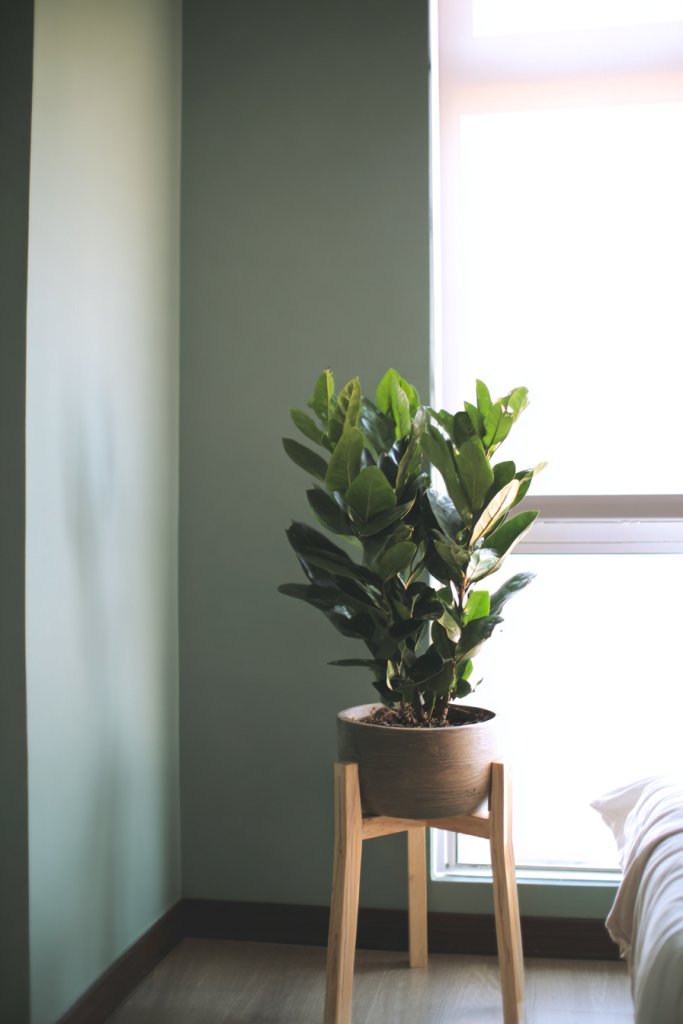
Want to bring life into your living room without creating clutter or maintenance nightmares? Indoor plants in wooden planters offer a natural, aesthetic solution. They add a splash of greenery that’s calming and refreshing, perfect for creating a balanced, organic vibe. If your space feels sterile or lacks a touch of nature, this approach is a simple fix.
Imagine a collection of low-maintenance succulents or lush ferns in handcrafted wooden pots placed on open shelves or side tables. The natural wood tones warm up the room’s neutral or sage palette, creating a seamless connection to nature. The plants’ varying heights and textures add visual interest, while their vibrant greens energize the space. The overall look is fresh, inviting, and effortlessly stylish.
Use different types of wooden planters—light or dark woods, carved or smooth finishes—to match your decor style. Incorporate plants suited to your light conditions and maintenance preferences. During different seasons, switch out plants to reflect changing moods—bright greens in spring, muted tones in winter. Pair with textured textiles or natural accessories for a layered, earthy look.
Choose sturdy, attractive wooden planters that fit your space and style. Place plants near windows or in well-lit areas for optimal growth, ensuring you select species suited to your environment. Use drainage trays to prevent water damage and avoid overwatering. Regularly dust or wipe the planters for a fresh appearance. Incorporate a few taller plants for vertical interest and smaller ones for tabletop displays.
Personalize with custom engraved or painted planters, or add decorative stones or moss for texture. Mix in different plant types—succulents, leafy greens, or flowering varieties—while keeping a cohesive color theme. Use decorative stands or risers to elevate some plants, creating layers. Keep your greenery healthy with occasional pruning and attentive watering.
Indoor plants in wooden planters breathe life into your space, making it vibrant and calming. They connect your decor to nature and improve air quality. With a little care, they become a dynamic, evolving part of your home’s personality. Ready to give your living room a natural upgrade? Plants are your new best friends.
14. Creating a Focal Point with a Large Framed Mirror
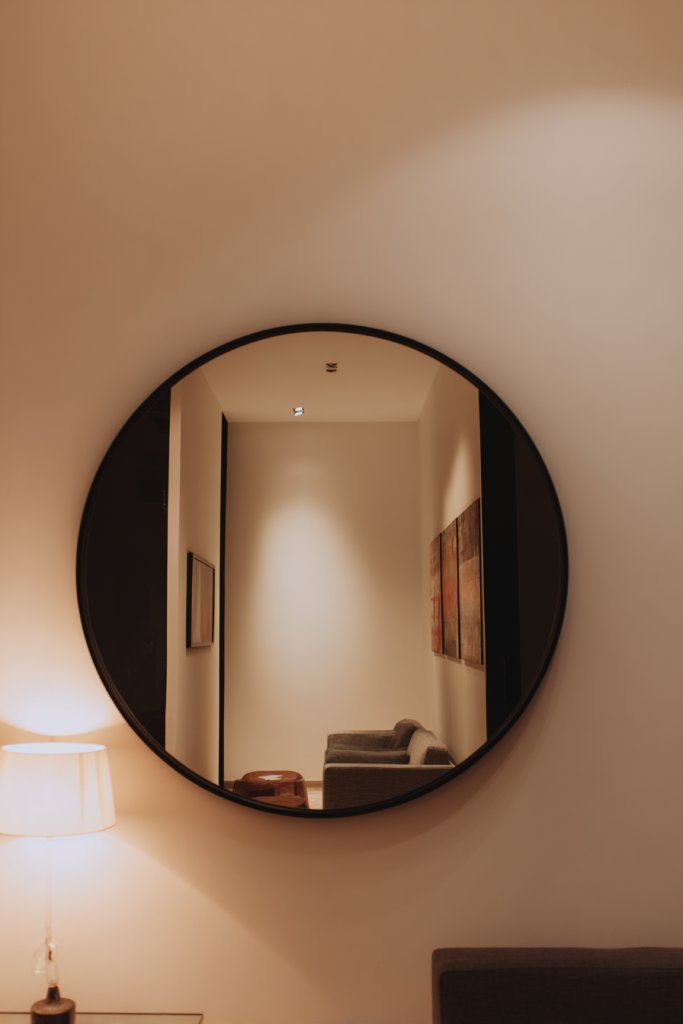
Ever feel like your living room lacks depth or brightness? A large framed mirror can instantly double the sense of space and reflect light, making any room feel bigger and more open. It’s a simple, stylish way to create a visual focal point without cluttering your walls. If your space feels flat or narrow, this trick will open things up.
Imagine a sleek, minimal mirror with a slim, matte black or brushed gold frame hanging above your sofa or fireplace. It reflects the room’s natural light, brightening even the darkest corners. The mirror’s size anchors the wall, creating a striking visual center that draws the eye. Pair it with simple, elegant furnishings to keep the focus on this statement piece. The result is a room that feels airy, balanced, and stylish.
Choose frames that match your decor—sleek metal for modern, wood for warm, rustic vibes. Use multiple mirrors in different sizes for a gallery wall effect, or keep it simple with one large piece. Hang at eye level or slightly above to maximize impact. During different seasons, decorate around the mirror with textiles or accessories—avoiding restricted decor—to keep it fresh.
Select a mirror with a sturdy frame and appropriate size for your wall. Use wall anchors and hooks rated for the weight; ensure it’s securely mounted. Choose a location that reflects a pleasant view or enhances your main seating area. Keep the mirror clean with a soft cloth and glass cleaner, avoiding streaks. Consider adding LED lighting around the frame for extra glow.
Personalize with decorative trim or paint accents on the frame—avoiding restricted decor—adding a unique touch. Incorporate small decorative objects nearby—like candles or textured sculptures—without cluttering the space. Use the mirror as a backdrop for a gallery wall with artwork or family photos, ensuring the overall look remains balanced. Play with placement to find the best reflection and visual effect.
A large mirror enhances your living room’s spatial perception and light, creating an elegant, spacious environment. It’s a versatile piece that suits many decor styles and can be easily updated. When placed well, it becomes a focal point that elevates the entire room. Want a quick, impactful upgrade? A mirror is your new best friend.
15. Implementing a Monochromatic Sage Green Palette with Variations
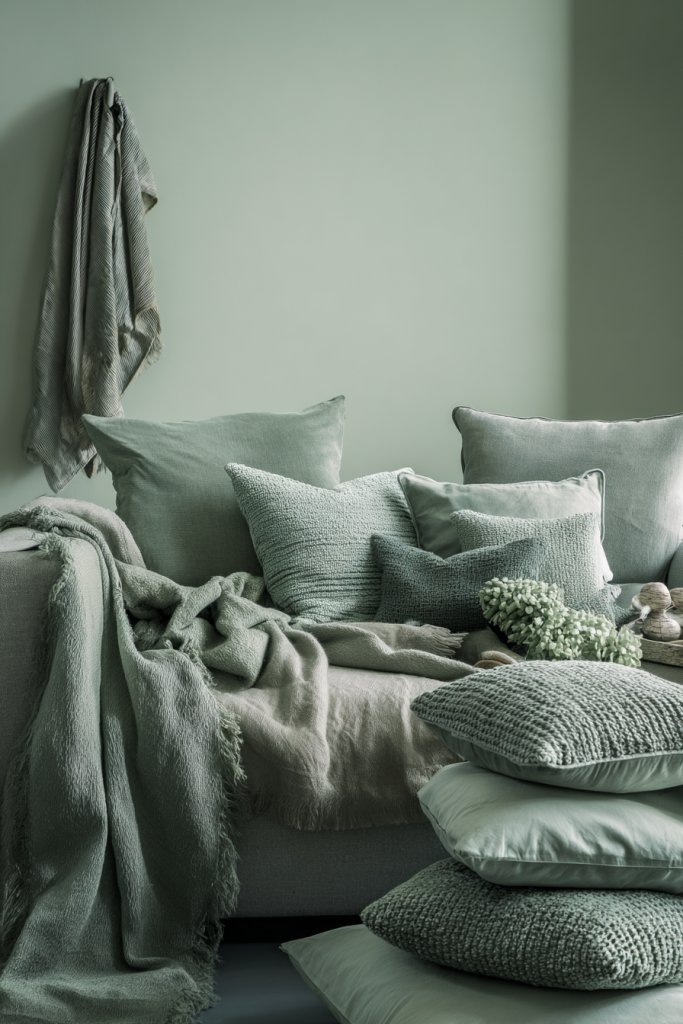
Craving a cohesive, peaceful environment that feels intentional and calm? Monochromatic palettes, especially variations of sage green, create a harmonious look that’s easy on the eyes. They foster relaxation and ensure your decor feels unified without being boring. If your space feels disjointed or overly busy, sticking to a monochrome scheme offers clarity and serenity.
Imagine walls painted in a soft sage, complemented by cushions, throws, and curtains in slightly different shades of green. Use furniture with subtle variations—like a darker green armchair or a lighter rug—to add depth. Accents in muted metallics or natural textures keep the look layered but cohesive. This palette creates a tranquil, sophisticated room that’s pleasing to the eye and easy to style.
Mix different tints and shades within the same color family for visual interest. During different seasons, you can introduce warmer or cooler tones within the palette—think olive greens in winter or minty shades in summer. Use textured textiles and layered finishes to add complexity. You can also incorporate neutral or soft contrasting colors—like blush or beige—for subtle variety.
Start by selecting a primary wall color in a medium sage tone. Layer in textiles—cushions, rugs, curtains—in varying shades, textures, and finishes. Keep furniture neutral or in matching shades to avoid breaking the scheme. Use accents like picture frames or decorative objects in similar hues to tie everything together. Maintain balance so no single element dominates, creating a seamless, calming aesthetic.
Introduce personal touches through different textures—think boucle cushions or velvet throws—in your chosen palette. Incorporate subtle metallic or wooden accents to add a touch of contrast. Use artwork or decorative objects that echo the color scheme without overwhelming it. Keep accessories minimal but meaningful, emphasizing harmony and serenity.
A monochromatic sage green palette offers a timeless, elegant look that’s easy to refresh and adapt. It promotes calmness and clarity, perfect for a peaceful home environment. With thoughtful layering and subtle variations, your space will feel cohesive and inviting. Want a serene sanctuary? Start with a unified, layered green palette—your space will thank you.
16. Incorporating Textured Throw Pillows in Complementary Neutrals
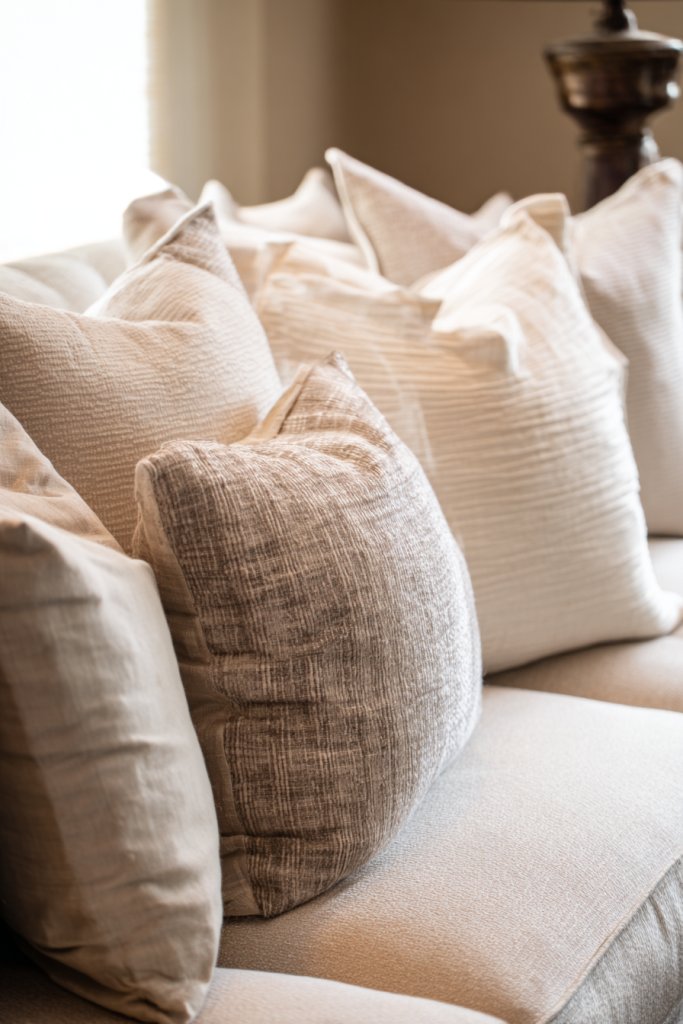
Feeling like your sofa is missing that extra layer of comfort and style? Textured throw pillows in neutral tones can instantly soften your living space while adding visual interest. They’re an easy, affordable way to refresh your decor without drastic changes. If your seating looks flat or uninspired, this simple upgrade can make a big difference.
Imagine a plush beige or taupe pillow with a chunky knit or embroidered surface placed on a sage-green sofa. Mix in different textures—such as velvet, boucle, and woven fabrics—to create a tactile feast. The varied surfaces catch light differently, adding depth and richness. These pillows turn your seating into a cozy, layered haven that invites lingering and relaxation.
Choose pillows in shades close to your sofa or wall color for a seamless look, or introduce slight contrast with muted blush or warm taupe. During different seasons, swap in textured covers or pillows with subtle patterns to keep things fresh. Use a mix of sizes—large bolster pillows and smaller square cushions—for a dynamic, inviting arrangement. Keep the overall palette neutral to maintain harmony.
Select high-quality pillows with removable covers for easy cleaning. Incorporate textures like boucle, knits, or embroidered fabrics for tactile variety. Arrange pillows symmetrically or asymmetrically, depending on your style preference. Regularly fluff and rotate for even wear and to maintain their plush appearance. Use inserts that provide good support without losing shape.
Add personalized touches by choosing textured covers in your favorite neutral shades or with subtle patterns. Incorporate decorative trims or piping for extra detail. Mix in pillows with metallic or faux-fur accents—avoiding restricted decor—to elevate the look. Incorporate these pillows into a broader layered decor scheme for a cozy, curated feel.
Textured neutral pillows make your seating look plush and inviting while effortlessly elevating your decor. They add depth and personality without overwhelming your space. With simple swaps and layering, your living room becomes a cozy, stylish retreat. Want to refresh your space in minutes? Textured throw pillows are your secret weapon.
17. Using Statement Floor Lamps with Organic Shapes
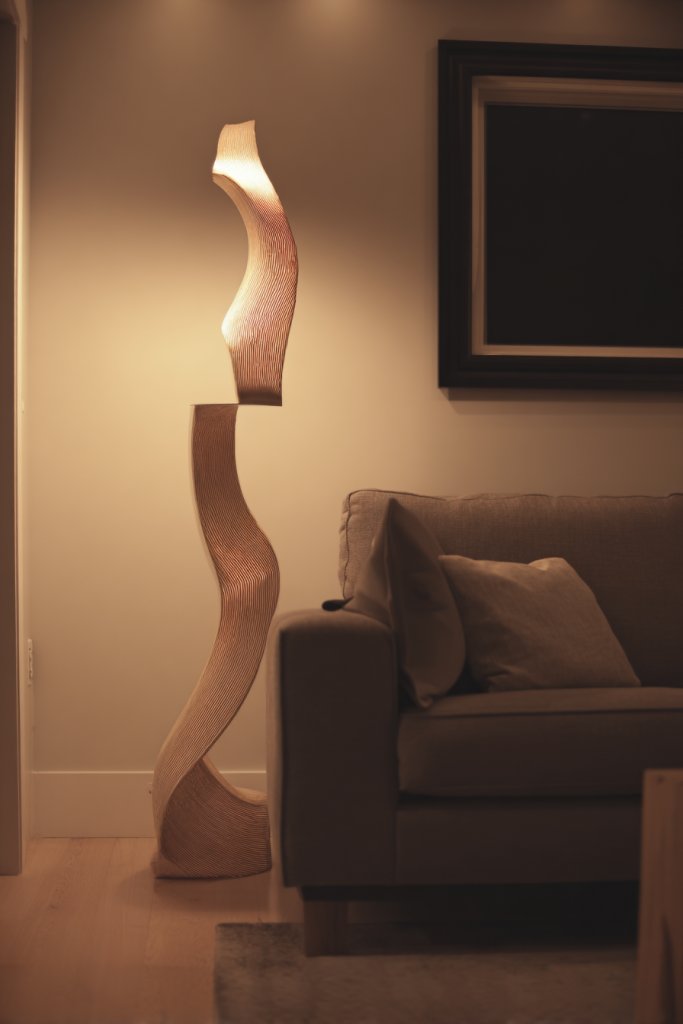
Ever wish your lighting could be both functional and a piece of art? Statement floor lamps with organic shapes bring a sculptural element to your living room while providing much-needed illumination. They serve as focal points that add personality and style. If your space feels flat or lacks visual intrigue, a bold lamp might be just what you need.
Imagine a tall, sculptural lamp with a curving, organic form in matte black or brushed brass—standing gracefully beside your sofa. Its shape mimics natural forms like a tree branch or flowing water, adding a touch of nature-inspired art. The soft glow from its shade or bulb highlights its unique design, casting interesting shadows. It becomes a functional piece of art that elevates the entire room’s aesthetic.
Choose lamps with sculptural, flowing shapes that complement your decor style—modern, boho, or Scandinavian. During different seasons, pair with textured shades or fabric covers in neutral or warm tones. Use dimmable bulbs to control ambiance, making the lamp versatile for daytime reading or evening relaxation. Position it to frame your seating area or create a cozy corner.
Select a statement lamp with a sturdy base and a design that resonates with your style—preferably in a neutral or metallic finish. Place it where it can be seen and appreciated, like beside a sofa or in a corner. Use a compatible dimmer switch for adjustable lighting. Clean the lamp regularly, especially the shade, to maintain its aesthetic appeal. Balance it with other decor for a cohesive look.
Personalize with different bulb types—warm LEDs or vintage-style filament bulbs—to enhance the organic shape. Incorporate textured or fabric shades to add softness and contrast. Pair with complementary decor objects, like textured side tables or woven baskets, avoiding restricted decor items. Let the lamp’s sculptural form stand out as a piece of functional art.
A statement organic-shaped lamp transforms your space into a gallery of functional artistry. It adds visual interest, warmth, and personality—all with a single piece. Plus, it’s a conversation starter that showcases your unique style. Ready to make your living room both stylish and inviting? An organic statement lamp is your new best friend.
Conclusion
Exploring these diverse Sage Green Living Room Ideas reveals how versatile and captivating this color can be in transforming your space. Embrace these concepts to create a tranquil, stylish retreat that truly feels like home. Take the leap and incorporate sage green into your living room—you’ll be amazed at how it can elevate your entire space and mood!
Leave a Reply